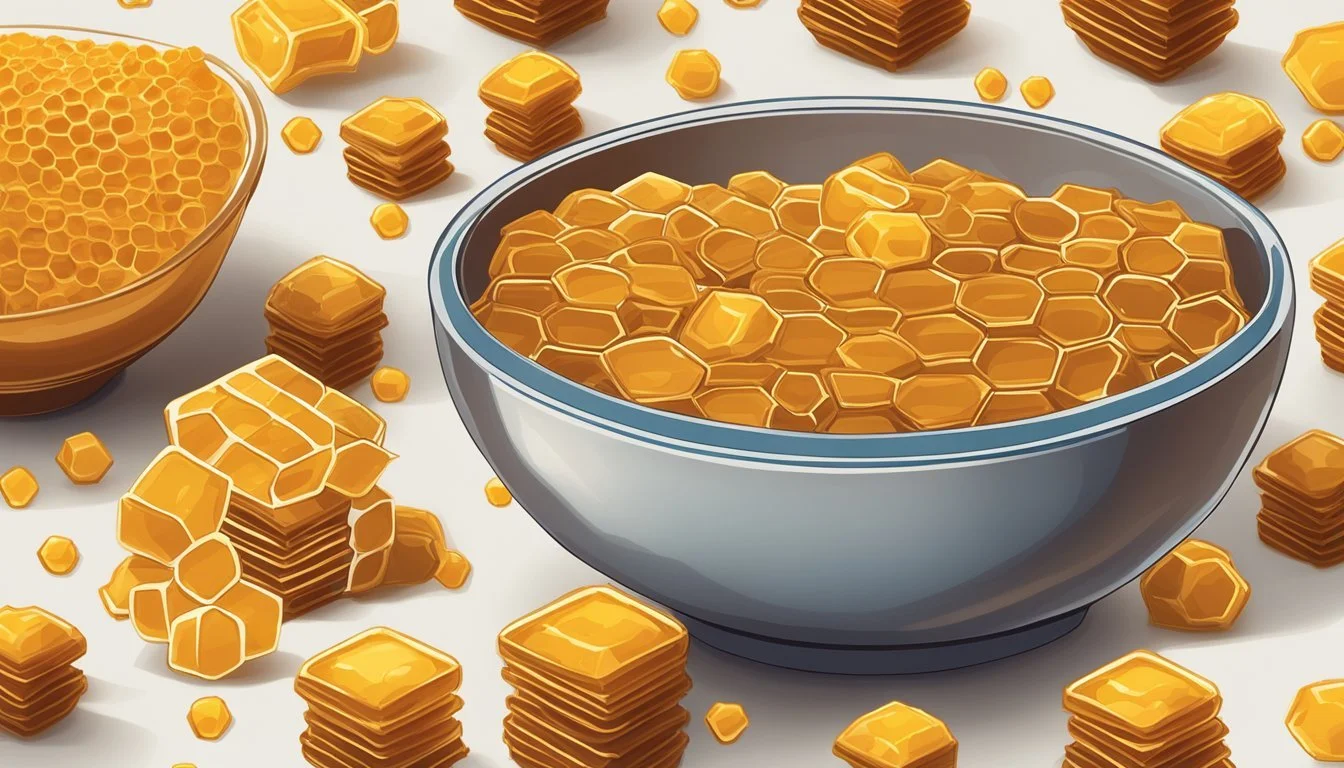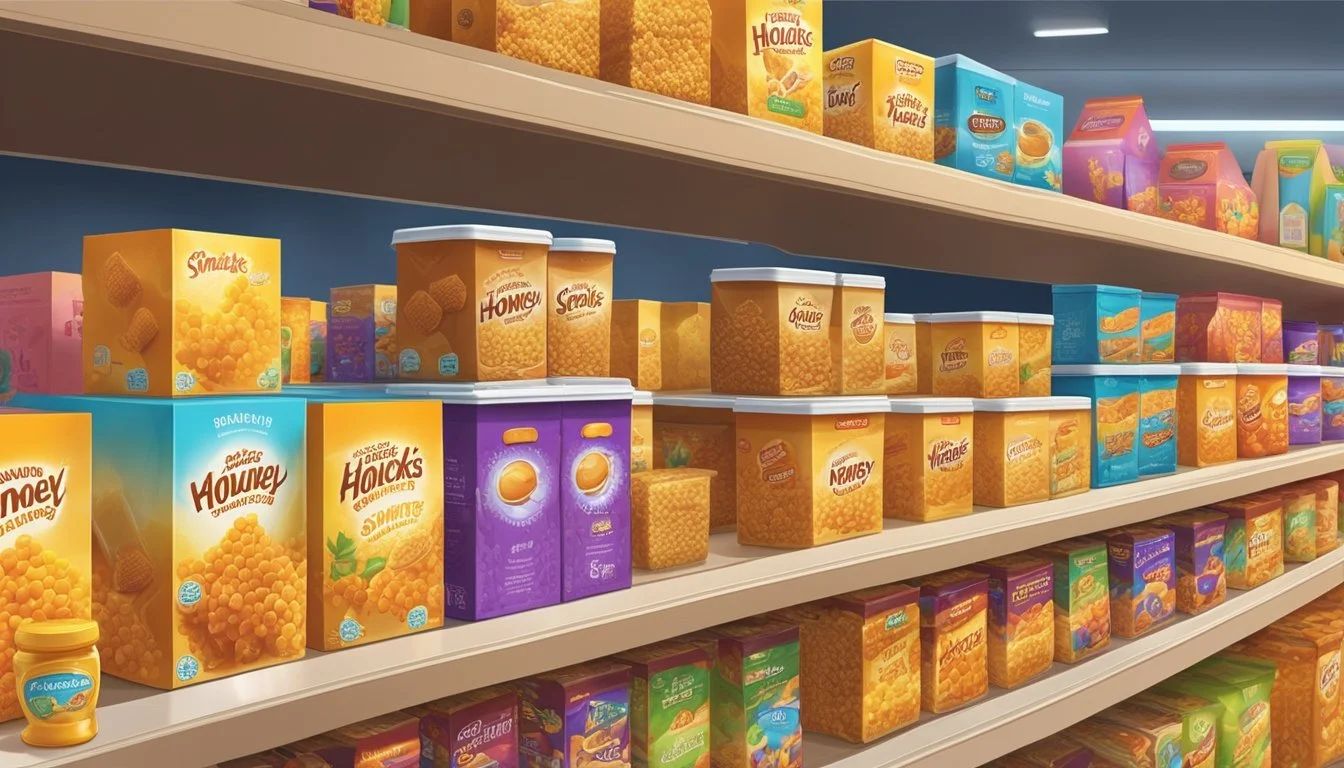Honey Smacks vs Honeycomb
Comparing Breakfast Cereal Giants
This Article is Part of Our Breakfast Cereal Guide with Details on Honey Smacks Nutrition and Honeycomb Nutrition
When it comes to choosing between Honey Smacks and Honeycomb, both cereals offer distinct nutritional profiles and flavor experiences. Honey Smacks, known for its sweet and toasty flavor, packs a hefty 18 grams of sugar per serving, making it a favorite for those who enjoy a sugary start to their day. On the other hand, Honeycomb offers a less sugary alternative with larger, hexagon-shaped pieces that provide a different texture.
Parents and health-conscious consumers often scrutinize the sugar content in breakfast cereals, and for good reason. Honeycomb is generally considered healthier due to its lower sugar content compared to Honey Smacks. With consumers increasingly looking for nutritious options, this aspect becomes crucial.
In addition to sugar content, both cereals differ in vitamins and minerals. Comparing the specific nutritional benefits of each can help consumers make a more informed choice about what to place in their shopping carts and breakfast bowls. These factors play a significant role in determining the right cereal for an individual's needs and preferences.
Overview of Honey Smacks
Honey Smacks, a well-known cereal in the U.S., has a rich history and distinct nutritional qualities. This section discusses its origins, ingredients, and how consumers perceive it today.
History of Honey Smacks
Honey Smacks, originally launched by Kellogg's in the 1950s, has undergone various rebrandings over the decades. Initially named "Sugar Smacks," the name change in the 1980s to "Honey Smacks" reflected a shift in marketing strategies as health consciousness grew among consumers.
In the 1990s, the mascot "Dig'em Frog" was introduced, adding to its recognition and popularity. Despite these changes, the formula has remained largely consistent, characterized by its sweet, honey-coated puffed wheat.
Nutritional Profile
Honey Smacks is a high-carbohydrate cereal, with one serving containing approximately 110 calories. The predominant ingredients are wheat, sugar, and honey, contributing to its sweet flavor.
Additionally, a serving of Honey Smacks typically contains:
Fiber: Less than 1 gram
Protein: 2 grams
Fat: 0.5 grams
Saturated Fat: 0 grams
In terms of vitamins and minerals, Honey Smacks provides a notable amount of iron and vitamin B6, but is relatively low in other nutrients such as potassium. The high sugar content remains a concern for many health-conscious consumers.
Consumer Perception
Honey Smacks has a nostalgic appeal, often associated with childhood memories. Its distinct honey flavor and crispy texture make it a favorite among many cereal enthusiasts.
However, perceptions vary significantly. While some consumers appreciate its taste and occasional indulgence, others criticize the high sugar content and lack of substantial nutritional benefits.
Health advocates particularly highlight its minimal fiber and protein content, rendering it less suitable for those seeking a nutritious start to their day. Despite these criticisms, Honey Smacks continues to maintain a loyal following due to its unique flavor profile and historical significance in the cereal market.
Overview of Honeycomb
Honeycomb Cereal, produced by Post Consumer Brands, is known for its unique hexagon-shaped pieces and distinct honey flavor. This section covers the history, nutritional content, and market positioning of Honeycomb.
History of Honeycomb
Honeycomb Cereal was introduced by Post in 1965. The cereal gained popularity quickly due to its light texture and honey-flavored sweetness. Over the decades, Honeycomb has undergone several recipe changes, often to improve nutritional value while maintaining its signature taste. Its recognizable shape and branding have kept it a staple in many households, appealing to both children and adults.
Nutritional Content
Honeycomb Cereal is notable for its balance of macronutrients and vitamins. A typical serving contains 14 grams of complex carbohydrates, which provide a quick source of energy. The cereal is also fortified with essential minerals such as iron and calcium, as well as vitamin B12, supporting overall health. Honeycomb has moderate sodium levels, typically around 180mg per serving, and is low in cholesterol, making it a relatively heart-friendly option.
Nutritional Highlights per Serving:
Complex Carbohydrates: 14g
Sodium: 180mg
Vitamin B12: 25% of daily value
Calcium: 10% of daily value
Cholesterol: 0mg
Market Position
Honeycomb occupies a unique niche in the cereal market, combining nostalgic appeal with nutritional value. It competes with other honey-flavored cereals, including Kellogg’s Honey Smacks and Golden Crisp. Honeycomb's marketing often targets families, focusing on the taste children love and the nutritional reassurance parents seek. Promotions frequently emphasize the cereal's fun shape and sweet flavor, enhancing its market appeal.
In recent years, Post has maintained Honeycomb's visibility through strategic advertising and keeping the product affordable. This consistency has helped Honeycomb retain a loyal consumer base amidst a highly competitive market.
Comparison of Taste and Texture
Honey Smacks and Honeycomb differ significantly in taste and texture, appealing to different preferences. Both cereals bring unique flavors and textures that cater to varied tastes, from sweet and chewy to light and crunchy.
Taste Profiles
Honey Smacks offers a sweet, distinct honey flavor that mingles with a slight toasty note from the puffed wheat. It has a bold taste due to the honey coating, which makes it a favorite among those who enjoy intensely sweet cereals.
Honeycomb, on the other hand, features a milder sweetness with a slightly floral note. The taste is more subtle compared to the robust sweetness of Honey Smacks. The honey flavor in Honeycomb is less pronounced, which might appeal to those who prefer a less sugary breakfast option.
Texture Differences
The texture of Honey Smacks is chewy with a slight crunch when eaten dry. Once milk is added, the puffed wheat becomes softer but does not completely lose its chewiness, providing a satisfying bite until the end of the bowl.
Honeycomb, known for its light and airy structure, remains crunchy longer when milk is added. The hexagonal shapes are designed to maintain their structure, giving a consistent crispness throughout the eating experience. This makes it ideal for those who enjoy a long-lasting crunch in their cereal.
Health and Nutrition Analysis
When comparing Honey Smacks and Honeycomb cereals, key factors like sugar content and overall nutritional value come into play. These aspects are pivotal in determining the healthier breakfast option.
Sugar Content Comparison
Honey Smacks contains about 18 grams of sugar per serving. This high sugar content can contribute to health issues like obesity and diabetes if consumed regularly.
Honeycomb, while still sweet, has a lower sugar content at around 10 grams per serving.
Comparing the two, Honeycomb emerges as the better option for those mindful of their sugar intake. High sugar levels in breakfast cereals can spike blood glucose levels and provide little nutritional value.
Healthier Breakfast Choices
For a truly healthy breakfast, cereals should provide ample fiber and essential vitamins and minerals. Honey Smacks offers 1 gram of fiber per serving and contains vitamins such as B1. However, it falls short on whole grains and other nutrients like zinc and vitamin C.
Honeycomb also contains about 1 gram of fiber per serving, yet does not offer substantial amounts of whole grains or significant nutritional benefits.
A balanced breakfast should include cereals rich in whole grains and fiber, and fortified with essential vitamins and minerals for better health outcomes. Both options are not ideal for those seeking optimal nutrition but can be part of a varied diet if consumed in moderation.
Brand Positioning and Variations
Both Honey Smacks and Honeycomb cereals occupy unique spots in the breakfast market. While they both offer a sweet, satisfying crunch, their approach to branding and line extensions reveal different strategic choices.
Cereal Line Extensions
Honey Smacks, produced by Kellogg’s, focuses primarily on its flagship product. Smacks doesn’t have numerous variations, sticking mainly to its original honey-flavored puffed wheat recipe. This consistency helps maintain a straightforward brand identity. Special editions or variations might appear occasionally, especially for promotional events, but they rarely diverge from the main product in flavor or form.
Honeycomb, by Post, has taken a different route. Besides the original honey-flavored cereal, they have introduced different variations over time. Limited editions include flavors such as Cinnamon Honeycomb and Chocolate Honeycomb, catering to diverse consumer tastes. These efforts aim to keep the brand fresh and appealing to both old and new customers by offering periodic innovations.
Consumer Loyalty and Branding
Customer loyalty for Honey Smacks stems from a consistent brand experience. Kellogg's leverages nostalgia and familiarity, enhancing its appeal as a classic breakfast option. Kellogg’s, also known for other cereals like Frosted Flakes and Raisin Bran, uses its overall brand strength to bolster confidence in Honey Smacks among consumers. Simple and effective packaging highlights the cereal’s honey sweetness.
Post employs a broader branding strategy for Honeycomb. With various line extensions and a strong focus on family-friendly marketing, Honeycomb aims to appear dynamic and innovative. The recognizable honeycomb-shaped cereal pieces and engaging mascots foster a memorable brand presence. Additionally, they emphasize fun and adventure in their advertising to attract younger audiences and maintain consumer interest across generations.
Pricing and Availability
Honey Smacks and Honeycomb cereals are popular choices for a Saturday morning breakfast option. Their pricing can vary based on location, store, and time of purchase.
In general, Honey Smacks tends to be priced slightly higher than Honeycomb. A standard box of Honey Smacks usually costs around $4 to $6, depending on the retailer and promotional offers.
On the other hand, Honeycomb generally falls within the $3 to $5 range per box. This price variation can make Honeycomb a more budget-friendly option for families.
Availability of both cereals is widespread across major grocery stores and online platforms. They are regularly stocked in most regions, making them accessible for consumers.
During certain promotional periods or festive seasons, discounts and deals are often available. Checking store flyers or online retail sites can help in finding the best prices.
For bulk purchases, warehouse clubs like Costco and Sam's Club may offer larger packs at discounted rates, which can be ideal for families who consume cereals frequently.
In terms of special editions or limited-time flavors, availability might be more sporadic and prices can be higher due to the novelty factor. These editions often generate interest but usually come at a premium.
Consumer Preferences and Popularity
Consumer preferences for Honey Smacks and Honeycomb are shaped by taste, nostalgia, and nutritional content. By examining survey results and sales data, we get a clearer picture of which cereal wins in public opinion and market performance.
Survey and Poll Results
Recent consumer polls and surveys reveal mixed preferences. Many consumers favor Honey Smacks for its distinctive toasty flavor. They often describe the taste as nostalgic and reminiscent of classic Saturday mornings.
In contrast, Honeycomb is favored by those seeking a lighter, crunchier texture. Some surveys, including those conducted by cereal-focused forums, indicate Honeycomb appeals to a younger audience.
Popularity among similar cereals like Golden Crisp and Apple Jacks also influences preferences. For example, while some fans of Lucky Charms might gravitate towards Honey Smacks due to its sweeter profile, others prefer Honeycomb for its lower sweetness.
Sales Data Analysis
When analyzing sales data, Honeycomb often shows stronger performance in terms of volume sold. This may be due to larger family pack sizes and frequent promotions.
On the other hand, Honey Smacks maintains consistent sales, often driven by brand loyalty and unique flavor. Honey Smacks typically sees a spike in sales during holiday seasons when nostalgia-driven shopping increases.
Comparisons with other cereals like Kashi reveal a trend towards consumers choosing Honey Smacks for sweetness and Kashi for health benefits. This interplay among different cereal brands helps highlight why both Honey Smacks and Honeycomb maintain strong positions in the market despite their differences.
Sales figures suggest that while Honeycomb might sell more, Honey Smacks enjoys a dedicated consumer base, consistent enough to sustain its market presence.
Cereal in Popular Culture
Cereal has long held a significant place in popular culture, often becoming associated with cherished childhood memories. Saturday mornings, in particular, have become synonymous with bowls of sugary cereal and marathon cartoon sessions.
Iconic Mascots: Both Honey Smacks and Honeycomb have memorable mascots. Honey Smacks featured characters like Cliffy the Clown and Dig'em Frog. Honeycomb brought in the Honeycomb Kid and Crazy Craving to entertain their audience.
Cereal mascots have become cultural icons, representing an era when marketing to children was done with creative, colorful characters.
Head-to-head battles between different cereals have also become notable in pop culture. For example, Honey Smacks has seen comparisons with other cereals like Golden Crisp due to their similar taste profiles.
Fans often engage in debates about their favorite cereals, creating a sense of community and nostalgia.
Marketing Campaigns: Advertising for cereals frequently involves television commercials, packaging designs, and catchy jingles that stay in the minds of consumers for years. This strong presence in media ensures that cereals like Honey Smacks and Honeycomb remain prominent in collective memories.
Engaging mascots and vibrant branding contribute to the lasting appeal and popularity of these cereals.
Cereal Portions and Collectibles
Limited-time offers and cereal box collectibles add another layer to the cultural impact. Prizes inside cereal boxes have encouraged generations of children to seek out certain brands not just for their taste but for the excitement of toys or other items.
Memorable marketing through diverse channels has solidified the status of cereals like Honey Smacks and Honeycomb in popular culture.
Conclusion
When comparing Honey Smacks and Honeycomb, each cereal has unique qualities.
Honey Smacks is known for its sweetness and toasty flavor. It's marketed primarily for its taste, which many enjoy as a nostalgic reminder of classic childhood cereals.
Honeycomb emphasizes its crunchy texture and honey flavor. It also provides moderate sugar content and added fortification for essential nutrients.
Nutrient Honey Smacks (per 1 cup) Honeycomb (per 1 cup) Calories 110 120 Sugar 18g 10g Protein 2g 2g Sodium 50mg 170mg
Honey Smacks: High sugar content may be a concern for some, but it offers a distinctive toasty sweetness.
Honeycomb: Lower sugar content and fortified nutrients may be appealing, though it contains refined grains.
Ultimately, the choice may come down to personal preferences in taste and nutritional priorities.








